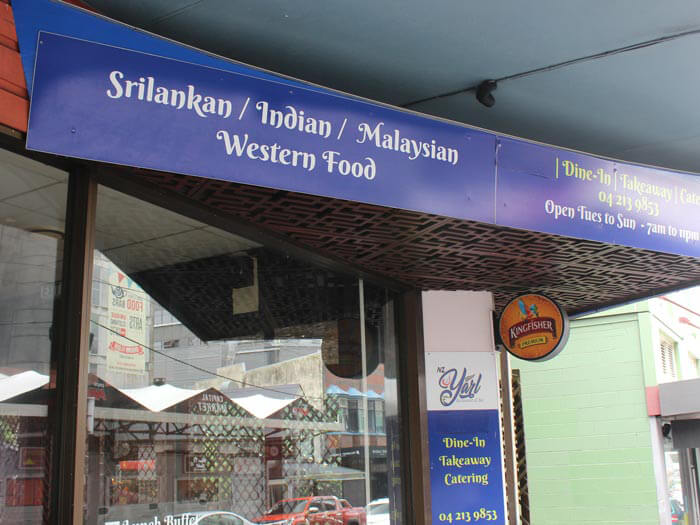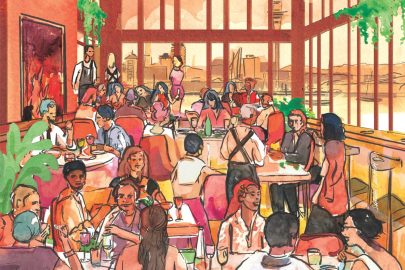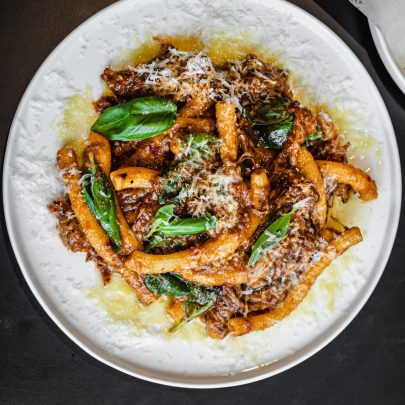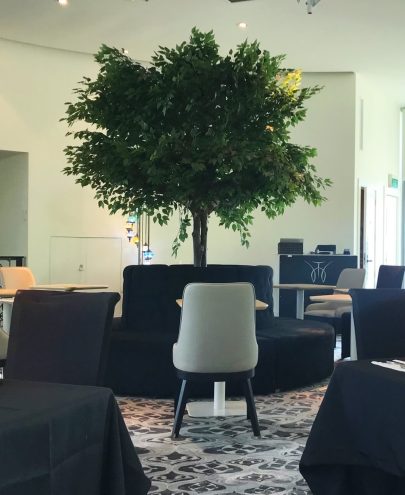Feb 20, 2020 Restaurants
Why Wellingtonians are hard-pressed for good food and how a culinary hero’s refugee-dream was wasted on us.
This story originally appeared on Noted.co.nz and has been shared with permission.
“What’s the best restaurant in Wellington at the moment”? I was asked enthusiastically by people at an important party months ago. A perfect escape rope for me, nervous yet bored from the preceding conversation. Revived by the question, I still struggled to respond. Do they want to know what I like, or do they want to know what I like from the category of things I think they like? Should I speak of something incredible but unfamiliar to them, effectively reinforcing my otherness, or play it straight with a convivial and robust conversation about the best burgers? W. E. B. Du Bois’s theory of Double Consciousness cutting me close.
NZ Yarl, aka the Yarl, used to be a restaurant at the less businessy end of Willis Street, sat across the road from the now bustling Capital Market food court. It offered Wellington something less familiar: a shop serving bonafide Tamil South Indian and Sri Lankan ‘banana leaf’ cuisine, of such quality that could rival the best in Asia. Remarkably, the Yarl never garnered any attention or praise from either the established food critics in town or the heaving glassy ocean of Insta-famous food bloggers. Perhaps an eerie reflection of the increasingly parochial, brand-rewarding, bark-not-bite reality that inhibits so much of the vaunted Wellington food scene we hear about. The Yarl’s short run leaves us with a trail of reflections.
Dreams of Yarl
In January 2018, Theeban Neruraja, the head chef and owner of the Yarl, and his family arrived as quota refugees from Kuala Lumpur, Malaysia, where they had spent the last 10 years awaiting resettlement after fleeing Sri Lanka.
Theeban is a Sri Lankan Tamil from the Jaffna region, the epicentre of violence that engulfed his homeland in a treacherous civil war between the Sri Lankan military and an inspired Tamil guerilla group from 1983 to 2009.
Jaffna, known as Yalpanam in Tamil, is on the northernmost tip of Sri Lanka. Owing to its geographical proximity to the Indian subcontinent and South-East Asia, Sri Lankan cuisine reflects this and can be oversimplified as rice on a banana leaf with an assortment of curries wet or dry, chutneys, bread and crisps. Further, we find seafood, lentils and regional vegetables, like jackfruit and bitter gourd. Nourishing, hot and bright, think dosa, hoppers and plenty of coconut.
At age 24, Theeban left his home, his life, war-torn and vacated. He sought refuge in Kuala Lumpur (KL). With an imperative to survive, nothing further to lose, and without recognisable skill, Theeban first found work in high-end Western eateries, pumping out among other things: Angus steaks, pasta salads, and fat-boy burgers. Later, he switched tunes and worked in Chinese restaurants; kong bo chicken, xiaolongbao, no stone unturned. Not unlike many wage workers in the pits of commercial kitchens, the accumulation of savings, skills and repetitive tasks in these years, offered him latitude to dream his food vision.
This nascent, occupying idea got going after a day in Brickfields, the suburb known as ‘Little India’. Theeban spotted a gap in the market: KL was awash with Indian eateries, mainly the ubiquitous Mamak restaurants, serving time-honoured local hybrid Malaysian-Indian cuisines such as nasi khandar and roti chanai, or other South Indian variations, or even Northern Indian classics. Yet, food from Sri Lanka remained distinctly absent.
But Theeban was plagued by a major problem to any entrepreneurial ambition: he was illegal. Still true today, Malaysian law does not make any distinction between undocumented workers and refugees, including refugees like Theeban, who have legal refugee status through the UN Refugee Agency. This meant any type of hustle would be work where he risked arrest, detention, or even intimidation from thriving local gangs. While daunted, Theeban insisted it was a small price to pay to feed the family.
In 2008, the Yarl – shorthand for Yalpanam – made its debut as a roadside cart on a side street in Brickfields. Contrary to expectations, there was no bite. Three months later, undeterred, sleeves folded higher and still believing in the quality of his cuisine, queues began to form before lunch hour. Every day Theeban would prepare a Sri Lankan food greatest hits lists of crab curry, shark puttu, fried puttu, kottu roti, kool and of course, hoppers. Profits jumped ten-fold and the Yarl, still the new kid on the block, was getting all the buzz. It was the word on everyone’s lips, he recalls with pride; murmured, hushed and exclaimed, “Yaarl”, “Yaaarl”, “Yaaaarl”. Theeban cites his Malaysian mate Radha, with whom he shared a common “Dravidian consciousness”, as an enabling force, supporting his dream with plenty of street smarts, not least in the legal hoop-jumping.
Half a year later, in an attempt to satiate their ever-growing diverse clientele, the Yarl went big. The Yarl Malaysia was formed, a bonafide restaurant with an extended menu, table service, hot and cold beverages, and food served hot on a light green banana leaf. These were the boom years, the food hopping off the shelf and the restaurant featured in the national broadsheet. Theeban proved that good food sticks, no matter the circumstances.
When New Zealand called after a strong ten-year run with the Yarl, Theeban saw it as an opportunity for his kids, and to move away from the predatory dangerous KL gangs. Saying goodbye to the Yarl must’ve been tough, but no doubt he had done it before.
Translating food, a compromise?
Dining at the NZ Yarl for the first time, it was no surprise to me that Theeban managed all these feats. Tasting his rava masala dosa for the first time, a semolina-based dosa, I noticed the crisp shell with bubbles (a reflection of good fermentation), and the warm slightly mashed potato filling piqued with cumin and fennel seeds. The accompanying coconut chutney hit every note of savoury. This was also true of the accompanying sambar, a lentil-based vegetable stew, which was perfectly earthy. Left in a daze, I knew I’d just had something very special. No dosa in Wellington comes even close to this, and believe me, I’ve tried them all.
NZ Yarl served lunch buffet spreads too, including chicken curry, lamb rendang, crab curry, dal, fried bitter gourd, and vadai all part of a generous array.
Theeban’s signature dish was the shark puttu. Puttu is roasted rice flour mixed with coconut left to steam inside bamboo. The shark Theeban used is the familiar fish ‘n’ chip faithful, lemonfish. (When I suggested using a different type of firm-textured fish, such as warehou, Theeban recoiled and emphasised the seemingly unlikely flavour virtues of the lemonfish). Then, the puttu and lemonfish were mixed through the rice, furthered with lashings of hot mustard oil and crispy curry leaves. The dish tasted like a coconut breathed nasi goreng. Another speciality and Sri Lankan street food icon, the kottu roti, is comprised of hacked up fresh roti fried on a hot plate with vegetables, meat, egg, and a spike of curry sauce. This dish, which can also be made vegetarian, is a universal delight. I now understood why the Sri Lankan cricket team were dining here every day last summer, between Tests at the Basin and their hotel.
Theeban rightly foresaw that Yarl Malaysia’s success could not be directly transplanted to New Zealand. It would be a matter of understanding and adjusting to local tastes, custom and palate. You just couldn’t see the average Kiwi smashing idiyappams (rice noodle pancakes) in the morning with sambar and coconut chutney.
Theeban admits that he didn’t know much about New Zealand before getting the green light to settle here. For him then, like many others around the world, relevant Kiwi cultural food mapping may have included: drinking at a pub, fish ‘n’ chips, steak, chops, a faint wonder of what Maori cuisine was, blandness (not a pejorative) and lots of dairy.
With earnest effort and help from the Red Cross, Theeban attempted to accommodate and mitigate this dissonance first, with the time-honoured safety of rolling out a menu that upped the dairy content, with renditions of ‘Anglo-Indian’ favourites like butter chicken, korma and even a full tandoor oven. Anxious that this might not be enough to sway food-risk-averse Kiwis, Theeban also added a full ‘Western’ spread to the Yarl’s arsenal, including favourites like steaks, chops and fish ‘n’ chips.
The result: a very expansive, or even ‘eclectic’, menu which featured Sri Lankan, Indian (North, South, Anglo), Malaysian and Western cuisine. This is probably where the NZ Yarl got its secondary name; a name in quote marks, riddled with no irony or pretence – “Contemporary Cuisine”. Keen not to let Kiwis down, the Yarl was fitted with intentional pub stylings, a bar and live sports screenings out the back, all part of the grand compromise or misplaced vision. At the NZ Yarl, you could get a cold Kingfisher, a steak and the game.
The writing may have been on the wall for some, but a steady stream of loyal South Asians who ‘know what’s up’ kept the Yarl going. Some of NZ Yarl’s misgivings were expected for any new restaurant – food inconsistency and tricky service, which didn’t match the serious-restaurant vibe it had set itself. However, the bigger elephant in the room was that this was a misconceived attempt at assimilation; a bid to smoothen out an identity that was digestible and easy on the palate for everyone around.
The full spectrum contemporary menu was a dizzying read, confusing the essence of the restaurant. It reflected a restaurant possibly uncertain or at odds with its own identity. Caught up in the tandoor or Western sections, the Sri Lankan cuisine page never got a look-in. I heaved a sigh as I considered the regrettably ‘pub-like’ setting. This attempt at being a bar can only ever register to me as tragically endearing. Suffocated from the fine dining table arrangements, how I wish I was left with just my fingers, clumsily eating all this goodness off a banana leaf instead.
While the Yarl’s menu appeared diverse, many of the Malaysian, South Indian and Sri Lankan dishes overlap through its Tamil connection. It is hardly unique for restaurants that brand themselves as ‘South Indian’ in Wellington, to have long been serving dishes better associated with the North, think chicken makhani (butter chicken), but irredeemably sweet. This is part of a larger problem, less to do with supply than demand.
Not surprisingly, as seen with Theeban’s attempt at compromise, the great challenge for many restaurants and caterers in Wellington, particularly ‘ethnic’ ones, is the lack of population numbers. To be commercially viable it isn’t enough to feed your own, or those travelled or woke enough to recognise “authentic” flavours. Thus the necessity to reinvent dishes along the lines of the palate of the majority ethnic group to cast as wide a net as possible.
This taken to its extreme results in restaurants like Mr Go’s on Taranaki Street; a place that does well filling every night with people of the same ethnicity, and winning Wellington on a Plate awards. But of course Mr Go’s isn’t an Asian or ‘ethnic’ restaurant or anything close to it; it’s just intentionally styled to be one. It is white food with an ‘Oriental spin’ for folks looking for something ‘different’. The proof that East Asians would never go anywhere near Mr Go’s is all we need to know.
For all this talk of ‘compromise’, what made the Yarl a very special place in Wellington was that, where it counted, Theeban made no compromises. It was as a colonialist might utter, “remarkably untouched”. The dishes that made the first iteration of the Yarl in Malaysia a success were served here fully intact, not watered down or creamed up, not mild in heat, not ‘refined’, and certainly not polished Asian food “with a touch of class”, à la David Burton. The plastic faux banana leaf plates may as well be real, as the cuisine was as real as it gets.
Yarl can’t stop me
In an era where global capital allows for both a flow of overseas food outlets, fads and tastes to be warmly embraced and replicated to varying success (think bagels or poke for example), I wonder when we can offer that same enthusiasm for something different. An iteration of food that belongs to someone from the margins, someone unlike you, that has proven its finesse in what would seem to be more challenging contexts than this one. If the food of Yalpanam only gets tolerated and then ignored with a smile, would this be considered a ‘fair go’? If Wellington is a town of foodies, how could such quality food go remiss, without faint mention, like, or tag? Should Theeban have collaborated with a manicured craft beer brand instead, or enlisted the help of zombified food-grams? Perhaps, but let us not fall prey to our blind spots, to unappreciate the ill-attempt at assimilation. Assimilation that is a prerequisite to any restaurant success story in a city with a 76 percent Pakeha majority.
I reflect on the hardest part of fitting in, the cautious wonder of what it is that you are fitting into. If you wouldn’t have me for my sweet chicken korma and buttered naan, why should I risk offering you my jackfruit curry and chicken peratal? The worse part of fitting in would be to try hard to be the thing you think people want and then to be completely rebuffed. And that’s not because you misread the crowd, but rather, the crowd too caught up in its little world, wasn’t even reading in the first place.
The NZ Yarl shut for good in early March this year; in the end, it was an unlikely kitchen fire that put them out. Stuck in a tricky legal battle, hard-pressed for representation and in debt, Theeban’s nation-topping refugee food dream was brought to a halt. “I’ll be back one day, don’t worry”, Theeban shrugs with a smile that parted to me both sorrow and promise.
I later browsed through the Wellington on a Plate brochure feeling dejected. From degustation to kitsch burgers, how many iterations of Pakeha food does it take to believe we have diverse taste?
“Yaarl”, “Yaaarl”, “Yaaaarl”, I heave the words, if only we were the people we tell ourselves we are.
This story originally appeared on Noted.co.nz and has been shared with permission.






